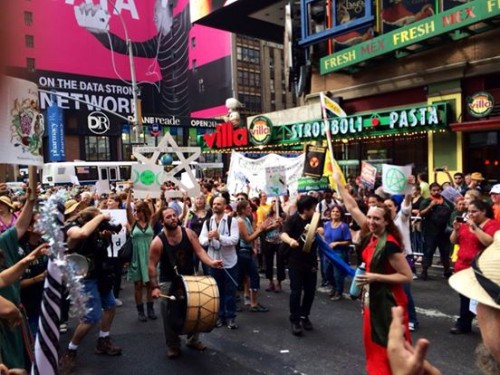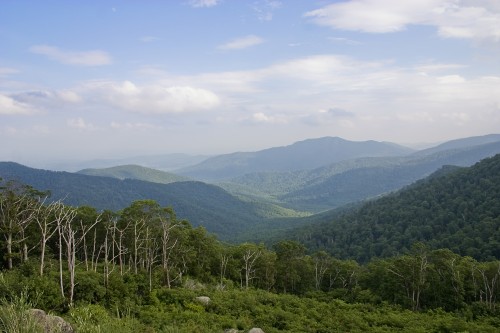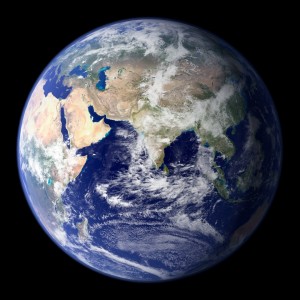In 2014, an estimated 300,000 people marched through the streets of New York City and another 40,000 in London in the biggest protest to draw attention to global climate change. The protesters came from all walks of life to stand together to raise awareness and demand action. The landmark event demonstrated, if nothing else, the universality of the concern and the growing acceptance that climate change must be addressed now.

PEC members hold an impromptu ritual during the march. (Credit: Groundswell Movement)
However, for the average person, affecting real change can become overwhelming and discouraging. Where do I begin? What can I do? Will recycling a newspaper or using cloth grocery bags actually help? In a past Wild Hunt article on fracking, activist Courtney Weber, co-founder of Pagan Environmental Coalition – New York City, said, “I can’t fight for bees, deforestation and the black rhino. Philosophically I can. But practically I can’t.” She recommended that people, ‘Pick what’s local. Pick what makes you mad.”
Unfortunately, even at a local level, there seems to be an overwhelming number of causes that can make “you mad” from polluted waters and the KXL pipeline to deforestation of rainforests, such as in Tasmania, and the near extinction of species, such as the Black Rhino. Where does a single person begin to affect real change? Not everyone can be a full-time activist.
In recent article for AEON magazine, writer Stewart Brand makes an interesting observation, which may help to answer this question. Brand claims that “the idea that we are edging up to a mass extinction is not just wrong – it’s a recipe for panic and paralysis.” He argues that many people focus on a single extinction or threat, and fail to see the bigger picture. He wrote:
No end of specific wildlife problems remain to be solved, but describing them too often as extinction crises has led to a general panic that nature is extremely fragile or already hopelessly broken. That is not remotely the case. Nature as a whole is exactly as robust as it ever was – maybe more so, with humans around to head off ice ages and killer asteroids. Working with that robustness is how conservation’s goals get reached.
Brand’s concept can be applied well-beyond species protection, in that he compares environmental conservation to human medical care. While one scratch or bruise must be treated properly, these smaller ills are either isolated issues, or indicative of a far larger health problem. Like human wellness, conservation work should focus its resources on identifying and solving the larger problem, and on the general, sustainable health of the entire system – in this case, the ecosystem.
In other words, Brand argues that conversation science and environmental activism should look to repairing and balancing our world’s ecosystems, rather than only focusing on small fixes. And, according to the article, this thinking seems to be trending. He wrote, “As the new science of conservation biology came into its own in the 1980s and ’90s, focus shifted away from concern about the fate of individual species and toward the general health of whole ecosystems.”
With this shift to holistic Earth health, humanity’s role as protector changes. Within that perspective, we become a functioning part of the system, from the micro to the macro. As such, it becomes easier to locate a working role in conservation efforts, both from a practical and religious perspective. John Halstead, editor of Humanistic Paganism.com, said:
Part of my morning devotional is to take a moment on my way to my car to squat down and touch the earth. I reach my fingers through the grass or leaves or snow until I feel the dirt under my fingers, and then I recite a paraphrase of a poem by Mary Oliver: ‘The god of dirt came up to me and said ‘now’ and ‘now’ and ‘now’, and never once mentioned forever.’ This helps make my Paganism feel real. The feeling of wet or cold or just the “dirt-ness” reminds me not to romanticize nature. It reminds me that my deity is not the Goddess of the Earth, but the Goddess that is the Earth, the Earth that this very real dirt is a part of. And it reminds me that that my Paganism needs to mean something for the health of the very dirt under my fingers and everything it is connected to.
Similarly, Pagan artist Lupa said, “My path is Earth Stewardship. Not in the sense of chaining myself to giant redwoods or yelling at people online because their environmental choices are not my environmental choices. Mine is a quieter revolution based on trying to model better behaviors, ones that I’ve come to through many hours of considering the choices before me. I try to live as though everything is sacred, because to me everything is nature and nature is what I consider sacred.”

[Photo Credit: JSmith / Flickr]
When referencing “faith,” Marshall is speaking of monotheistic religious practices. He does not address Paganism, Polytheism or Heathenry, many of which already exist at his coveted intersection. As demonstrated by Lupa and Halstead, many of these traditions function with a crossover between the understanding of human spirituality (drive and emotions) and the literal and scientific understanding of place (nature). Editor of Polytheist.com Anomalous Thracian wrote:
“Place” is a concept that gets talked about a lot in Polytheist religion, especially in discussions about regional cultus. In my practice, discussions of “place” are not abstract, but direct and literal, referring to both the specific spirits and deities of that specific place, as well as the physical expressions of that place. Groves of trees, formations of stone and earth, flowing currents of water, are not mere aesthetic assemblage to assist in the desperate grabbing and reaching after mental balance or sense of inner meaninglessness, but instead are — in their vibrantly material presence — the cornerstones of it all, where belief and practice converge.
The personhood-of-place, and its hierarchical placement in literal consideration, realized relational configurations and intentional interaction within the dynamics of hospitality and recognized role, are how it all starts. The places within the natural elemental world are the places where the gods reach through first to touch our lives in raw and visceral fashion, and it is these selfsame places that must be guarded not as holiest of relics but as holiest of relations. The actively and directly engaged protecting of this world, as a collective whole and in its individual places, is paramount to the authentic and embodied expression of any Polytheist endeavor and identity, for without the humility to know one’s place in the natural world one can never hope to hold true piety at the feet of the blessed gods.
Similarly Rev. Selena Fox, who worked closely with Wisconsin Senator Gaylord Nelson, founder of Earth Day, on the very first celebrations, sees no distinction between her religious and environmental work. She said, “Environmental conservation and green living are essential parts of my life and work as a Nature religion priestess. In addition to tending shrines and ceremonial areas at Pagan sacred land, Circle Sanctuary Nature Preserve, I am part of ecological restoration, research and conservation endeavors there. Our national Pagan cemetery, Circle Cemetery, is one of the first Green cemeteries in the USA — … Ecological activism is sacred work.”
Although Thracian and Fox practice very different religions, their personal sense of place within the greater natural system, and the health of that system are paramount to both of their beliefs and their daily work. One cannot exist without the other.
Lou Florez, rootworker and witch, also agreed, saying, “I collect trash from rivers and ocean beaches, specifically from the areas where I give offerings and do rituals. I’m also cultivating a small medicine garden to engage a more sustainable relationship. When we talk about Earth-based traditions we are talking about being in connection, investing ourselves in the health and well-being of the land that sustains us.”
The sense of place within the ecosystem, in some form, appears to exist within the religious and spiritual practices of many Pagan, Heathen and Polythiest communities, whether or not the practice itself is considered Earth-based from an environmental perspective. This correlates to Brand’s notion of affecting change through holistic Earth health. As such, Pagans, Polytheists, Heathens may be helping to bridge that perceived gap between religion and environmentalism, as noted by Marshall.
Within the interfaith movement, that already seems to be the case. As mentioned in an earlier Wild Hunt article, Covenant of the Goddess’ Interfaith Representative Don Frew “relayed a story on how the 1990s global focus on the environment led to a greater interest or support for Nature-centered religions within the international interfaith world. Unfortunately, interest waned after 9/11.” Frew added that this is once again shifting.
Co-writer of CoG’s Environmental Statement and Interfaith Representative Aline (Macha) O’Brien said, “My way of expressing devotion, to Earth, to Mother Nature, to different deities, is to chant or sing.” O’Brien relayed a story in which she led a spiral dance at an interfaith wedding using “The Pleiades Chant.”* She said, “Shortly after the wedding, at MIC’s annual interfaith prayer breakfast, my friend Sister Marion of the Dominican Sisters of San Rafael came up to me and asked, ‘Now, how did that chant go?’ She said it had been running through her head and she’d really loved it and wanted a refresher on the wording. ”
Much of the work described, such as chanting, rituals and devotionals, are indicators of a spiritual connectivity between religion and place, from within the global ecosystem, rather than independent from it. While those actions alone will not heal the environment or balance the system, they do demonstrate a profound shift in thought. Courtney Weber said:
Turning this tide is tough work. Whether it’s denial, greed, or being overwhelmed by the problem’s size, somehow, the mere truth that we need to change our ways in order to preserve our species is not enough incentive to get enough people on board. Religion can hurt the environmental movement—particularly religions, which believe that a better life in a different world awaits humanity, or a desperately optimistic belief that “everything will work out as God/ess intended.” But religion can benefit the movement by instilling a moral imperative into its practitioners that preserving and improving our environment is a mark of grace and therefore, something that cannot wait.
Brand is optimistic saying, “The trends are favourable. Conservation efforts often appear in the media like a series of defeats and retreats, but as soon as you look up from the crisis-of-the-month, you realise that, in aggregate, conservation is winning.” The diversity and size of the attendance at the climate march is also sign of that favorable trend, as is the support for the “Pagan Community Statement on the Environment.” Awareness is a beginning.

Courtesy: NASA / Goddard Space Flight Center
Lupa agreed, saying “I want to invite others to retake their place amid the rest of nature, not as conquerors or guilt-ridden relatives or throwbacks to some dark age, but as members of a community. We’ve had plenty of doom and gloom about what will happen if we continue what we’re doing; I want to show people the benefits and joys of living closer to the land, whether that’s on a remote farm or (like me) in an urban apartment.”
Going back to the original question, “How can I help?” The big picture of environmental health can begin in very small ways, with the tiny ecosystems in our backyards, farms, empty city lots, terrace gardens or even public parks. If all these areas were regularly maintained as balanced, healthy ecosystems, they would, over time, eventually meet up, covering the world-over and, thereby, creating one big healthy, sustainable Earth.
* Author’s Note: “The Pleiades Chant” (via Aline ‘Macha’ O’Brien) “There’s a part of the Sun in an apple; There’s the part of the Moon in a rose; A part of the flaming Pleiades; In every leaf that grows.”
The Wild Hunt is not responsible for links to external content.
To join a conversation on this post:
Visit our The Wild Hunt subreddit! Point your favorite browser to https://www.reddit.com/r/The_Wild_Hunt_News/, then click “JOIN”. Make sure to click the bell, too, to be notified of new articles posted to our subreddit.

Listen to the “Pleiades Chant” mentioned in the article here: http://www.ivodominguezjr.com/Panpipes_Pagan_Chant_Site/chants/the-pleiades-chant.html
Just want to remark on the folk process that has changed the tune just a bit from the way I teach it to the way Ivo, et al., have recorded it. “There’s a part of the sun in an apple.” The word apple is on a higher note, not a lower one. (Don’t know formal music that well so cannot tell you what the notes are.) It’s great to have it recorded, tho. May it be widely used. It helps keep the memory of the wonderful Bone Blossom alive.
Righteous column, Heather! Thanks!
(The ‘s’ is missing from the final word ‘grows’ in Pleiades chant.)
The last name of the Senator who founded Earth Day was dropped in the text. Sen. Gaylord Nelson.
The history of the earth has shown us life is resilient. The earth has hosted several mass extinction events, from the massive volcano eruptions over millennia that marked the end of the Precambrian period to the asteroid impact that ended the age of the dinosaurs. The earth has survived the “snowball” period that was seen before plate tectonics formed separate continents. The earth will survive humans. The issue to people should not be “save the polar bears”, the species we see now are only “intermediate” forms and are still evolving. The message conservation should have always had -“save humanity”. I don’t think any biologist doubts the oceans would restock themselves once humanity has ceased to exist. I don’t think any biologist doubts the forests or the coral reefs would recover once humans disappear. The recent domination and indoctrination of humanity under Christianity cannot be discounted. We humans accept the toxic idea of a transcendental deity that “gave” us the earth to exploit, that life is only a temporary delay to the “promise of heaven”, and that an apocalyptic end to the planet is expected. I still see that idea of an apocalyptic end to the planet even among the most atheistic of scientists. The only end result of our complete disregard to the environment will be the end of humanity, not the end of the planet. If we disappeared tomorrow as a species, a planetary visitor 5000 years from now would have little evidence we ever existed. The planet is over 4 billion years old.